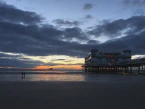Deadly Waters: Five Hazardous Swimming Destinations

5 Deadly Destinations You Should Never Swim In
As an expert copywriter and a travel enthusiast, I cannot emphasize enough the importance of safety when exploring new destinations. In this blog post, I’ll take you on a journey to five of the most dangerous bodies of water on our planet. I hope to inspire you to explore the beauty of our world, but also to remind you that not every picturesque location is safe for a leisurely swim. Here are five places where dipping your toes could have severe consequences.
Kipu Falls, Hawaii, USA: A Beautiful but Deadly Attraction
Kipu Falls is a stunning natural wonder hidden in Hawaii, often attracting tourists who enjoy diving from the top of the waterfall. However, this seemingly innocent activity has proven fatal for several visitors. The reasons behind the falls’ dangerous nature remain a mystery, with theories ranging from an anguished water spirit to a bizarre whirlpool phenomenon. Due to the unexplained deaths, the area is now fenced off and considered trespassing. Campaigns are ongoing to remove Kipu Falls from guidebooks and signposts to prevent further tragedies.
Rio Tinto, Spain: A Toxic River with a Red Warning
Some hazardous locations are easy to spot, and Rio Tinto in Spain is one of them. The river’s red-stained water is a clear indication that it’s not a safe place to swim. Its high acidity, mainly due to mining operations, and elevated iron content make the river inhospitable to life. Interestingly, scientists study Rio Tinto as an example of extreme conditions, as it is more similar to the moons of Jupiter and Saturn than Earth.
The Bolton Strid, Yorkshire, England: A Deceptively Dangerous Creek
This seemingly harmless, narrow creek in Yorkshire, England, might appear safe at first glance, but don’t let its size fool you. The Bolton Strid’s slippery rocks, deep underwater crevices, powerful currents, and sharp stones make it a perfect storm of deadly conditions. If you fall in, your chances of survival are close to zero. Warnings about the Strid date back hundreds of years, including a tragic poem by William Wordsworth.
Laguna Caliente, Costa Rica: A Boiling and Acidic Volcanic Lake
Laguna Caliente, situated in the crater of the active Poas volcano in Costa Rica, may look like a pleasant hot spring in photos. However, it is both boiling hot and unbearably acidic, with a pH value lower than zero. The extreme conditions make it challenging even to approach the lake, let alone swim in it. Researchers are studying Laguna Caliente to understand how ancient life might have survived on Mars.
Hanakapiai Beach, Hawaii, USA: The Deadliest Beach in the World
As beautiful as it may appear, Hanakapiai Beach in Hawaii has earned its nickname as the deadliest beach in the world for good reason. First, reaching the beach is a challenge, with no road access and only a difficult hiking trail to follow. Secondly, inexperienced swimmers often fall victim to the deadly rip tides that are hard to spot if you don’t know what to look for. A wooden sign displaying the beach’s death toll serves as a chilling warning to potential swimmers. Thankfully, there are many other beaches in Hawaii that are safer for a relaxing dip.
Stay Safe and Explore the World Responsibly
As you plan your next travel adventure, I hope this list of dangerous destinations serves as a reminder to prioritize safety and research potential risks associated with your chosen locations. While it’s thrilling to visit breathtaking places and try new experiences, it’s essential to balance that excitement with caution and informed decision-making.
Remember, the world is vast and full of incredible places to explore. Be adventurous, but also be aware of the risks and dangers that come with certain destinations. By staying informed and respecting the natural environment, we can continue to appreciate our planet’s beauty without putting ourselves in harm’s way. Safe travels, and happy exploring!
Conclusion
In conclusion, our world is filled with awe-inspiring natural wonders and breathtaking landscapes that can captivate even the most seasoned travelers. However, the allure of these magnificent destinations sometimes masks the hidden dangers lurking beneath the surface. As adventurers and explorers, it is our responsibility to approach these locations with caution, respect, and a keen awareness of the potential risks involved.
By highlighting these five treacherous bodies of water, our aim is to underscore the importance of researching and understanding the places we visit, while also encouraging responsible travel. The beauty of these destinations is undeniable, but they serve as sobering reminders that nature can be as perilous as it is enchanting.
As you plan your future adventures, use this knowledge to make informed decisions about the places you choose to explore. Always prioritize your safety and the well-being of those around you. By doing so, you can continue to experience the wonders of our planet, while ensuring that your memories are filled with joy and excitement, rather than tragedy.
In the end, the essence of travel lies in discovering the rich tapestry of our world and connecting with the diverse array of cultures, environments, and experiences it has to offer. With a mindful approach and a spirit of curiosity, you can embark on incredible journeys that not only satisfy your but also foster a deeper appreciation for the delicate balance that exists within our natural world.
So, as you venture forth, be cautious, be informed, and cherish the incredible beauty our planet has to offer – while always remembering that a safe adventure is a truly rewarding adventure.
1. What precautions should I take when visiting potentially dangerous bodies of water?
Before visiting any potentially dangerous body of water, research the location thoroughly, understand the risks involved, and adhere to local warnings and regulations. If possible, consult with experienced locals, tour guides, or park rangers to get firsthand information about the area’s potential hazards. Always exercise caution, and avoid swimming or diving in locations with a known history of accidents or fatalities.
2. How can I identify a safe swimming location while traveling?
To ensure you’re swimming in a safe location, look for designated swimming areas, which are typically marked by signs, flags, or buoys. Check for any warnings or advisories posted nearby, and ask locals or lifeguards for advice. Additionally, pay attention to the water conditions, such as the presence of strong currents, rip tides, or hidden underwater hazards.
3. Are there any resources available to help me research potentially dangerous destinations?
Yes, numerous resources can help you research potentially dangerous destinations, including travel guidebooks, websites, and blogs dedicated to safety and adventure travel. Local tourism boards and park services often provide safety information and advisories on their websites. Online forums and social media groups can also be valuable sources of firsthand experiences and insights from fellow travelers.
4. Can I still visit these dangerous locations without putting myself at risk?
Yes, you can often visit these dangerous locations without putting yourself at risk, as long as you follow safety guidelines and stay within designated areas. It’s essential to respect local warnings, avoid trespassing, and refrain from engaging in risky activities, such as swimming or diving in prohibited areas. Appreciate the beauty of these places from a safe distance, and consider alternative activities like guided tours, photography, or simply enjoying the view.
5. How can I educate others about the dangers of these bodies of water?
To educate others about the dangers of these bodies of water, share your knowledge and experiences with friends, family, and fellow travelers, both in person and on social media. Write blog posts or share informative articles to raise awareness about these locations and their potential hazards. By sharing this information, you can contribute to a community of responsible, well-informed travelers who prioritize safety and environmental stewardship.



